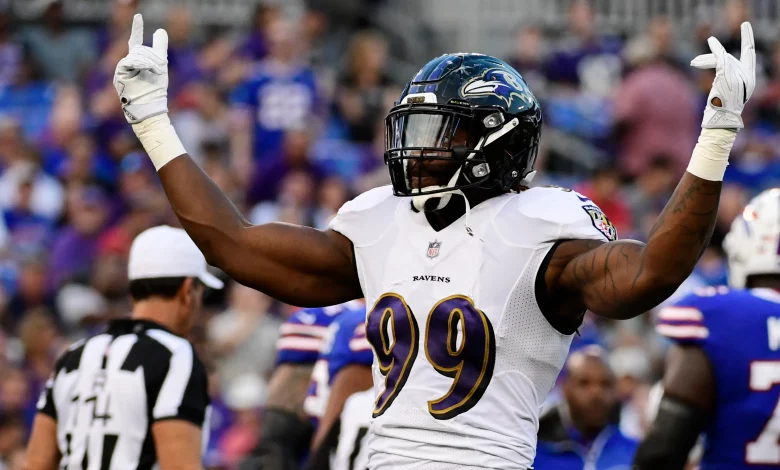The Ravens’ franchise tag history highlights strategic player retention, including key decisions on Terrell Suggs, Joe Flacco, and Lamar Jackson.

As the NFL’s free agency period approaches each year, franchises across the league face important decisions about which players to retain and which to allow to explore the open market. One tool that teams often utilize to maintain control over key players is the franchise tag. The franchise tag allows teams to retain a player for another season at a set salary figure, giving them more time to negotiate a long-term deal or ensuring the player remains under contract for one more year.
The Baltimore Ravens, known for their discipline, strategic decision-making, and focus on building a balanced roster, have used the franchise tag on several occasions throughout their history. While the Ravens’ front office has generally preferred long-term contract extensions over short-term solutions, the franchise tag has played a role in keeping some of their best talent in the fold during pivotal moments.
In this article, we will explore the Ravens’ history with the franchise tag, examining key players who have been tagged, the impact of those decisions, and how the franchise tag fits into the Ravens’ broader team-building philosophy.
Understanding the Franchise Tag: How It Works
Before diving into the Ravens’ history with the franchise tag, it’s important to understand what the tag actually represents. Under the NFL’s Collective Bargaining Agreement (CBA), teams can use one of three types of franchise tags:
- Exclusive Franchise Tag: This is the most restrictive form of the franchise tag. Players placed under the exclusive tag are prohibited from negotiating with any other team. The salary for an exclusive franchise tag is the average of the top five salaries at the player’s position or 120% of the player’s previous year’s salary, whichever is higher.
- Non-exclusive Franchise Tag: This tag allows players to negotiate with other teams, but the original team has the right to match any offer sheet or receive two first-round picks as compensation if they choose not to match the offer. The salary for a non-exclusive tag is the average of the top five salaries at the player’s position or 120% of the player’s previous season’s salary, whichever is higher.
- Transition Tag: This is a less commonly used tag and provides the team with the right of first refusal, meaning they can match any offer sheet made by another team. However, unlike the franchise tag, no draft compensation is awarded if the team chooses not to match. The salary for the transition tag is the average of the top 10 salaries at the player’s position.
The decision to apply a franchise tag is often a balancing act between wanting to keep a key player on the roster and negotiating a long-term deal that meets both the player’s and team’s needs. While the franchise tag ensures that the player remains under team control for another season, it can also cause tension, as the player may feel that the team is reluctant to commit to a long-term deal.
Ravens’ Franchise Tag History: Key Players
Over the years, the Ravens have used the franchise tag on several notable players, often in situations where negotiations for long-term contracts were still in progress. While the team has been known for avoiding prolonged contract standoffs, the franchise tag has sometimes been used to maintain control over key players in the midst of contract discussions.
1. Matt Stover (Kicker, 2003)
Matt Stover, one of the most accurate kickers in NFL history, was the first player the Ravens used the franchise tag on. In 2003, Stover, who had been with the Ravens since their inception in 1996, was coming off another solid season, and the team was looking to ensure that the veteran kicker remained with the team. The Ravens used the franchise tag on Stover, which allowed the team to retain his services for another season while they worked on a long-term deal.
Stover played one more season under the franchise tag before signing a long-term deal with the Ravens. He would go on to play an additional seven seasons in Baltimore, cementing his legacy as one of the franchise’s all-time greats. While the use of the franchise tag on a kicker may seem unusual by today’s standards, it was a prudent decision for the Ravens to maintain stability at such a crucial position.
2. Terrell Suggs (OLB, 2008)
Terrell Suggs, one of the most dominant pass rushers in NFL history, was tagged by the Ravens in 2008. Suggs had established himself as one of the league’s top defensive players, and the Ravens were looking to retain his services after his stellar 2007 season in which he registered 11 sacks and made the Pro Bowl. The Ravens used the non-exclusive franchise tag, allowing Suggs to test the market while giving the team the right to match any offers or receive two first-round picks in compensation.
Suggs signed the franchise tag but continued to push for a long-term deal. Eventually, in 2009, Suggs and the Ravens came to terms on a six-year contract extension, which allowed Suggs to remain a key defensive force in Baltimore for years to come. He played 15 seasons with the Ravens and became the franchise’s all-time sack leader. His use of the franchise tag in 2008 allowed the Ravens to buy more time to lock down a long-term agreement while keeping a key player in place during his prime.
3. Ray Rice (RB, 2012)
The most high-profile use of the franchise tag in Ravens history came in 2012 when the team tagged running back Ray Rice. Rice, who had been one of the league’s top running backs, was coming off a 1,300-yard, 12-touchdown season in 2011, and the Ravens were eager to keep him in Baltimore. The team placed the non-exclusive franchise tag on Rice, guaranteeing him the average salary of the top five running backs for the 2012 season.
The move was controversial in part because of the nature of the running back position. In an era where running backs were increasingly seen as interchangeable, there was debate about whether the Ravens should have committed long-term to Rice, who was approaching his late 20s. Nevertheless, the franchise tag allowed the Ravens to keep Rice on the roster while negotiations continued for a long-term deal.
After some back-and-forth, Rice and the Ravens agreed to a five-year, $35 million contract in July 2012. Rice continued to play a crucial role in the Ravens’ offense, helping lead them to a Super Bowl victory in the 2012 season. While the franchise tag was a temporary solution, it ultimately allowed the team to retain Rice during a crucial time in franchise history.
4. Joe Flacco (QB, 2013)
The franchise tag was again employed by the Ravens in 2013, but this time on quarterback Joe Flacco, the team’s Super Bowl MVP from the 2012 season. After leading the Ravens to a dramatic victory in Super Bowl XLVII, Flacco’s contract situation became a priority for the Ravens’ front office. Flacco had played out his rookie deal, and the Ravens needed to secure their quarterback for the long term.
The team applied the non-exclusive franchise tag to Flacco, which would pay him the average salary of the top five quarterbacks in the league for the 2013 season. However, the Ravens and Flacco quickly began negotiations for a long-term deal. After some contentious discussions, Flacco and the Ravens agreed to a six-year, $120.6 million contract, making Flacco one of the highest-paid quarterbacks in the league at the time.
Flacco’s long-term deal allowed the Ravens to solidify their quarterback position for years to come, and while Flacco would eventually fall out of favor in Baltimore, his Super Bowl victory remains a significant achievement in Ravens history. The franchise tag, in this case, gave the team leverage in negotiating the deal and allowed them to keep Flacco under control while discussions continued.
5. Lamar Jackson (QB, 2025)
The most recent and ongoing saga involving the franchise tag is the case of Lamar Jackson. Jackson, who won the NFL MVP award in 2019, is one of the most dynamic quarterbacks in the league. However, his contract negotiations with the Ravens have become a highly publicized topic. As of the 2025 offseason, Jackson remains without a long-term deal, and it is widely speculated that the Ravens could apply the franchise tag to him to keep him in Baltimore for another year.
The situation with Jackson is unique because, unlike most players who are negotiating extensions, Jackson does not have an agent. He has represented himself in contract discussions, leading to some tension between him and the team. Despite the lack of a long-term agreement, Jackson has proven himself to be a top-tier talent, and the Ravens are faced with the decision of whether to use the franchise tag to retain him for another season or to work out a deal before the deadline.
If the Ravens do use the franchise tag on Jackson, it will likely be the non-exclusive version, allowing Jackson to negotiate with other teams while giving the Ravens the right to match any offer. The tag would also allow the team time to further assess their future with Jackson and determine whether they are willing to meet his contract demands long-term.
The Strategic Role of the Franchise Tag in Ravens’ Team Building
The Ravens have generally favored long-term contracts over the use of the franchise tag, which has made them one of the more stable teams in the league when it comes to roster construction. Their use of the franchise tag has been somewhat limited compared to other teams, and when it has been used, it has been to keep key players around for another year while negotiations took place.
The Ravens’ front office is known for its focus on building a sustainable and balanced roster. Using the franchise tag allows them to maintain flexibility in their salary cap while keeping critical players in the fold. It also gives them time to evaluate players more fully before
committing to large, long-term contracts.
However, the use of the franchise tag can create some tension between players and teams, particularly when the player feels undervalued or desires a long-term deal. The Ravens have generally avoided protracted contract disputes, but with high-profile players like Jackson, the franchise tag could play a role in how the team approaches future negotiations.
Conclusion
The Ravens’ history with the franchise tag highlights the team’s strategic approach to roster building and player retention. While they have used the tag sparingly, it has been a useful tool in key moments, allowing the team to retain star players like Terrell Suggs, Ray Rice, Joe Flacco, and, potentially, Lamar Jackson. The franchise tag has allowed the Ravens to maintain flexibility in their cap space while also ensuring that they have the time needed to negotiate long-term deals.
As the 2025 offseason approaches, the Ravens may find themselves once again relying on the franchise tag to retain one of their most valuable players. The future of the Ravens’ roster will undoubtedly be shaped by how they navigate these key decisions in the coming years. The franchise tag is a reminder that, while long-term contracts are the ultimate goal, it remains an important tool in a team’s arsenal to maintain stability and continuity on the field.









